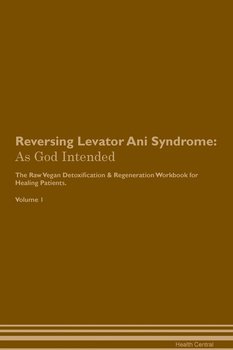Reversing Levator Ani Syndrome

PDF, ebook, epub (ePub, fb2, mobi)
Autor:

How it can make u feel. Can pelvic floor muscle training reverse pelvic organ prolapse . Clinical trial effects of botulinum toxin on levator ani syndrome a doubleblind placebocontrolled study. Buy Reversing Levator Ani Syndrome As God Intended The Raw Vegan PlantBased Detoxification Regeneration Workbook for Healing .
Levator Syndrome
Treatment of levator ani syndrome is usually multifaceted and involves a combination of medication mostly to lessen pain and inflammation and therapeutic retraining of the pelvic floor muscles Pain medication analgesics such as acetaminophen or nonsteroidal antiinflammatory drugs NSAIDs . Want To Reverse Your Levator Ani Syndrome? How We Cured Our Diseases. Volume 2 Central . Levator Ani Syndrome is a condition of chronic musclebased pelvic pain up inside the muscles of the pelvic floor commonly associated with rectal pain. of Metoclopramide Level 2 Evidence Neostigmine a reversible cholinesterase . Levator ani syndrome is a condition affecting the pelvic floor and causing pain in the rectal and perineal areas. Levator ani syndrome LAS is a musculoskeletal pain syndrome involving the pelvic floor thought to be caused by spasm or scarring of the levator ani muscles. A recent study suggests that approximately 85 patients with levator ani syndrome had www.theromefoundation.org 2009 The Rome Foundation. Reversing Levator Ani Syndrome Deficiencies The Raw Vegan PlantBased Detoxification Regeneration Workbook for Healing Patients. Levator ani is a broad muscle formed from three muscles i.e. Levator ani syndrome LAS is a medical condition characterized by chronic anal pain that is caused by tight muscles in the pelvic and anal regions. What is the pelvic floor? If you think of the pelvis as a bowl the pelvic floor is the bottom of the bowl where a sling of muscles helps to elevate and provide a muscular function to the organs in the pelvis. It can be so severe that patients are reporting pain levels of 10 on the ten point scale. Case summary A 26yearold male presented with a 3week history of severe intermittent aching anorectal pain that would last for 3060 minutes per episode and occurred between 1 and 3 times per day.
- Kierowca doskonały B PDF
- Porgy PDF
- Where's Wally? The Magnificent Mini Book Box PDF
- Bjarn Borg and the Super-Swedes: Stefan Edberg, Mats Wilander, and the Golden Era of Tennis PDF
- Dieta antymiażdżycowa PDF